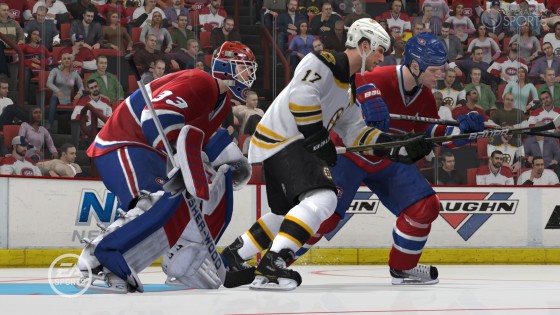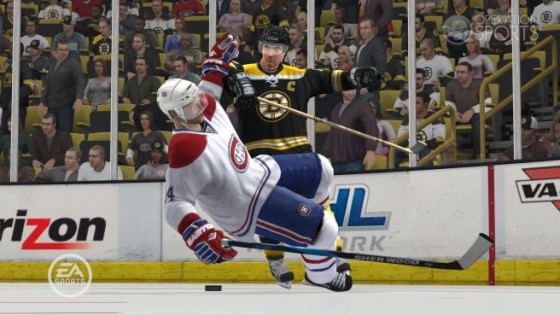

While tweaks to your lineup and strategies can subtly improve your chances at NHL 12, nothing quite beats having a mastery of what to do while actuallyplaying the game. No set style or attack pattern is going to be effective against everybody, but there certainly are key concepts to apply and pitfalls to avoid when taking on NHL 12's reasonably challenging AI, as well as the wide spectrum of online competitors.
Unpredictability: The Ultimate Weapon
It certainly would be foolish of me to say that doing one thing or another in NHL 12 is the right or wrong way, but I would argue that one of the main tenets of consistent play is variance. Clearly, there are plenty of talented players out there in the NHL 12 community. Many have mastered the usual array of dekes, one-timers and wrist shots that consistently produce goals, but this can also be a downfall when facing stiffer competition that knows how to deploy proper defense. Above all, varying up your offense – and defense, for that matter – forms good habits. If you just give an opponent the same look each time, AI or otherwise, he's going to shut you down and clog up the zone that you always gravitate towards.
Consider playing a game of catch between a winger and a defender, making the opposition shift their players and their focus while you decide what to do. Cycle behind the net and wait for the other team to make a mistake in coverage, leaving an easy tap-in goal. For one-timers, consider setting them up from further out than just the slot. One-timers in the slot will work, but everyone knows they're coming, and good teams will shut down most, if not all, of them. Above all, remember to get shots, as this year's game yields many more rebounds than before. Even low-wristers from the point, if properly screened, can result in easy goals off the rebound.

To Dump or Not to Dump
It's actually quite surprising how few teams online actually employ the dump-and-chase strategy, but it can be a nice variation from the usual rush or misdirection strategies. That said, the success rate for this play is usually around 33 percent, and some people might not be comfortable just handing over the puck if it fails.
If your team communicates and identifies the lone defender on one side, they can time their pursuit into the zone, aided by the clicking the R3 button for endurance boost, and then use board play to pin the opposition. This year, poke checks work quite well in board play, and if you dump, chase and follow that up by pinning someone along the wall, a poke check almost guarantees possession, even if it's just one on one. If you happen to take that puck from this strategy, a wraparound goal is almost certainly in your future.
A nice wrinkle to the usual flip dump is to actually pass the blueline on the wing and then execute the flip dump. This will ring the puck around the boards quite hard, allowing the opposite winger on your team a chance to gather the puck and attack on the weak side where the opposing team likely hasn't collapsed to yet. The timing on this play can be a bit finicky, but it's worth exploring.
Stick Defense: “With great power comes....”
To be sure, the current set of sliders for NHL 12 has greatly toned down the likelihood of drawing a penalty from a poke check. However, certain players online still insist on flaring out the stick whenever they're close to an opposing player. The thing to remember is that your player will now automatically sweep his stick when backskating, allowing for a small umbrella of coverage as you retreat. Also, you only want to attempt a poke check from the front. This is doubly true for the stick lift, which should be used even more sparingly. Rarely attempt to stick lift or poke check when behind an opposition player, as the likelihood of a penalty is greatly enhanced.
Many players online attempt to poke loose pucks past would-be defenders, which is an effective strategy. But also consider trying to poke a puck just as an opposition player is closing on it, especially if you're engaging him from the side. It seems that other players are quite vulnerable to the poke check when first touching the puck.

Hitting; It's All About Respect
Another aspect of the game that still has to be respected a great deal is hitting. With the addition of full-contact physics, this year's body checking loses something in its impact, but it gains a great variety in the ways players can be hit. With that in mind, it's important to realize that more than ever the hitting is truly user-controlled, meaning there's no magnetic lock-on to deliver the hit for you. A poorly timed hit from a defender usually results in a 2-on-1 opportunity, and a good team will bury odd-man chances.
Communication remains key here for identifying when hits are the way to go. If the opposition is crossing the blueline meekly and without speed, take that opportunity for a hit, but only if your team is closing on the player. It can be quite effective when one or two teammates “guides” an opposing player towards the blueline and the wing, as you'll have a prime opportunity to flatten them. Since your teammates encircled the player, there will likely be someone straddling the blueline, able to intercept a pass if it happens to be made before the hit.
As for hip checks, it's advisable to avoid using them very much, as EA has – thankfully – patched out their effectiveness in online play for the time being. Stick with well-timed hits on players that are indecisive or otherwise covered by your teammates.
Final Thoughts
Variety is indeed the spice of NHL life, and many players would be well served to inject a few different looks to their game. If you respect the tools that you are given and communicate with your fellow players, the results are there for the taking.




 Five Toughest Programs for Dynasty Mode in NCAA Football 12
Five Toughest Programs for Dynasty Mode in NCAA Football 12 NBA 2K12: Best Rebounders in the Game
NBA 2K12: Best Rebounders in the Game OS Tip of the Day: Know When to Charge the Net (Top Spin 4)
OS Tip of the Day: Know When to Charge the Net (Top Spin 4) OS Tip of the Day: Use Your Farm System in the Show
OS Tip of the Day: Use Your Farm System in the Show OS Tip of the Day: Stopping Breakaways (NHL 12)
OS Tip of the Day: Stopping Breakaways (NHL 12)